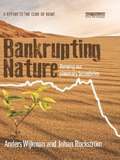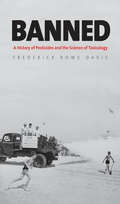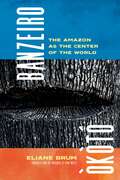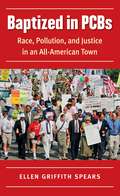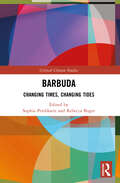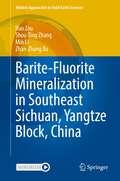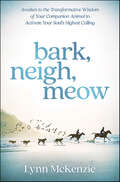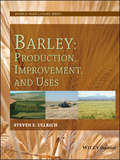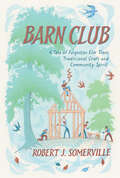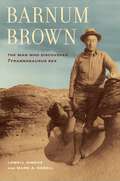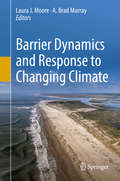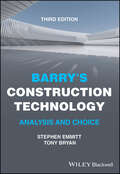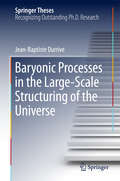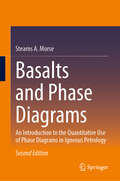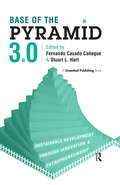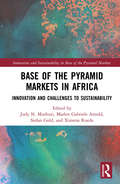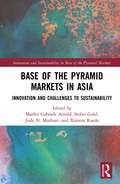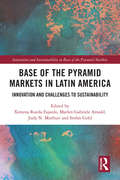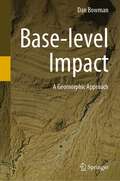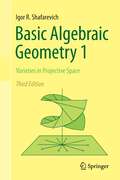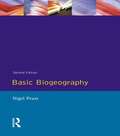- Table View
- List View
Bankrupting Nature: Denying Our Planetary Boundaries
by Johan Rockström Anders WijkmanThis powerful book shows us that we are in deep denial about the magnitude of the global environmental challenges and resource constraints facing the world. Despite growing scientific consensus on major environmental threats as well as resource depletion, societies are largely continuing with business as usual, at best attempting to tinker at the margins of the problems. The authors argue that regardless of whether governments respond to the economic crisis through additional stimulus packages or reduced government spending, environmental and resource constraints will remain. The crisis will be exacerbated by the combination of climate change, ecosystem decline and resource scarcity, in particular crude oil. The concept of Planetary Boundaries is introduced as a powerful explanation of the limits of the biosphere to sustain continued conventional growth. The book breaks the long silence on population, criticizing donor countries for not doing enough to support the education of girls and reproductive health services. It is shown that an economy built on the continuous expansion of material consumption is not sustainable. De-growth, however, is no solution either. The growth dilemma can only be addressed through a transformation of the economic system. A strong plea is made for abandoning GDP growth as the key objective for development. The focus should instead be on a limited number of welfare indicators. The trickle-down concept is seriously questioned, to be replaced by one of sufficiency. Rich countries are called upon to hold back their material growth to leave room for a rising living standard among the poor. Alternative business models are presented, such as moving from products to services or towards a circular economy based on re-use, reconditioning and recylcing – all with the aim of facilitating sustainable development. A Report to the Club of Rome
Banned
by Frederick Rowe DavisRachel Carson’s eloquent book Silent Spring stands as one of the most important books of the twentieth century and inspired important and long-lasting changes in environmental science and government policy. Frederick Rowe Davis thoughtfully sets Carson’s study in the context of the twentieth century, reconsiders her achievement, and analyzes its legacy in light of toxic chemical use and regulation today. Davis examines the history of pesticide development alongside the evolution of the science of toxicology and tracks legislation governing exposure to chemicals across the twentieth century. He affirms the brilliance of Carson’s careful scientific interpretations drawing on data from university and government toxicologists. Although Silent Spring instigated legislation that successfully terminated DDT use, other warnings were ignored. Ironically, we replaced one poison with even more toxic ones. Davis concludes that we urgently need new thinking about how we evaluate and regulate pesticides in accounting for their ecological and human toll.
Banzeiro Òkòtó: The Amazon as the Center of the World
by Eliane BrumA confrontation with the destruction of the Amazon by a writer who moved her life into the heart of the forest.In lyrical, impassioned prose, Eliane Brum recounts her move from São Paulo to Altamira, a city along the Xingu River that has been devastated by the construction of one of the largest dams in the world. In community with the human and more-than-human world of the Amazon, Brum seeks to “reforest” herself while building relationships with forest peoples who carry both the scars and the resistance of the forest in their bodies. Weaving together the lived stories of the region and its history of violent corruption and destruction, Banzeiro Òkòtó is a call for radical change, for the creation of a new kind of human being capable of facing the potential extinction of our species. In it, Brum reveals the direct links between structural inequities rooted in gender, race, class, and even species, and the suffering that capitalism and climate breakdown wreak on those who are least responsible for them.The title Banzeiro Òkòtó features words from two cultural and linguistic traditions: banzeiro is what the Amazon people call the place where the river turns into a fearsome vortex, and òkòtó is the Yoruba word for a shell that spirals outward into infinity. Like the Xingu River, turning as it flows, this book is a fierce document of transformation arguing for the centrality of the Amazon to all our lives.
Baptized in PCBs
by Ellen Griffith SpearsIn the mid-1990s, residents of Anniston, Alabama, began a legal fight against the agrochemical company Monsanto over the dumping of PCBs in the city's historically African American and white working-class west side. Simultaneously, Anniston environmentalists sought to safely eliminate chemical weaponry that had been secretly stockpiled near the city during the Cold War. In this probing work, Ellen Griffith Spears offers a compelling narrative of Anniston's battles for environmental justice, exposing how systemic racial and class inequalities reinforced during the Jim Crow era played out in these intense contemporary social movements. Spears focuses attention on key figures who shaped Anniston--from Monsanto's founders, to white and African American activists, to the ordinary Anniston residents whose lives and health were deeply affected by the town's military-industrial history and the legacy of racism. Situating the personal struggles and triumphs of Anniston residents within a larger national story of regulatory regimes and legal strategies that have affected toxic towns across America, Spears unflinchingly explores the causes and implications of environmental inequalities, showing how civil rights movement activism undergirded Anniston's campaigns for redemption and justice.
Barbuda: Changing Times, Changing Tides (Critical Climate Studies)
by Sophia Perdikaris and Rebecca BogerThis volume explores a range of themes including impacts of climate change, resilience, sustainability, indigeneity, cultural genocide, disaster capitalism, preservation of biodiversity, and environmental degradation. Focusing on the island of Barbuda in the West Indies, it shares critical insights into how climate change is reshaping our world. The book examines how climate has changed in the Caribbean over different spatial and temporal scales and how varying natural and anthropogenic factors have shaped Barbuda’s climatic and cultural history. It highlights projections of 21st-century climate change for the Caribbean region and its likely impacts on Barbuda’s coastal ecosystems, potable groundwater resources, and heritage. With essays by researchers from the United States, Canada, Caribbean, and Europe, this volume straddles a range of disciplines such as archaeology, anthropology, paleoclimatology, environmental sciences, science education, and Traditional Ecological Knowledge (TEK). Drawing on interdisciplinary and transdisciplinary approaches that explore the intersection of natural and social systems over the longue durée, the volume will be of interest to scholars, researchers, and students of ethnography, social anthropology, climate action, development studies, public policy, and climate change.
Barite-Fluorite Mineralization in Southeast Sichuan, Yangtze Block, China (Modern Approaches in Solid Earth Sciences #23)
by Min Li Hao Zou Shou-Ting Zhang Zhan-Zhang XuThis book describes the mineralization process of barite-fluorite deposits in southeastern Sichuan, Yangtze Block, China. Mainly through systematic field geological surveys and detailed indoor research work, the typical barite-fluorite deposits in this area were analyzed using a variety of analysis methods such as single fluid inclusion LA-ICP-MS composition analysis, trace rare earth element analysis, H-O-S-Sr isotope analysis, F element content analysis, and Sm-Nd geochronological analysis. By in-depth analysis of the ore-forming environment, mineralization process and geological characteristics of barite-fluorite deposits, the following were determined: (1) the source of ore-forming fluids of barite-fluorite deposits and (2) the migration, concentration, enrichment, and evolution of ore-forming sources, exploring the formation mechanism of barite-fluorite deposits. Summarizing the mineralization regularity of the deposit in this area of China provides a new insight and basis for the study of similar types of deposits in the world.
Bark, Neigh, Meow: Awaken to the Transformative Wisdom of Your Companion Animal to Activate Your Soul's Highest Calling
by Lynn McKenzieAccess the Guidance of Animals to Awaken Your Soul's Highest CallingFilled with amazing stories, step-by-step exercises, and thought-provoking discussions, Bark, Neigh, Meow shows how animal companions help you transform your life and fulfill your purpose. Animal intuition expert Lynn McKenzie is the perfect guide to creating meaningful connections with your beloved animals. You'll find greater passion, elevate your spirit, deepen your connection to the unseen realm, and much more. This remarkable book presents a heartwarming collection of Lynn's personal and client stories, revealing the full transformational power of animals. They can become your partners, teachers, guides, healers, catalysts, and even bridges to the other side. These phenomenal creatures want you to find the answers you need right now. With their help, you can heal from the past and blossom into the best version of yourself.
Barley: Production, Improvement, and Uses (World Agriculture Series #12)
by Steven E. UllrichBarley is one of the world's most important crops with uses ranging from food and feed production, malting and brewing to its use as a model organism in molecular research. The demand and uses of barley continue to grow and there is a need for an up-to-date comprehensive reference that looks at all aspects of the barley crop from taxonomy and morphology through to end use. Barley will fill this increasing void. Barley will stand as a must have reference for anyone researching, growing, or utilizing this important crop.
Barn Club: A Tale of Forgotten Elm Trees, Traditional Craft and Community Spirit
by Robert Somerville&“In today&’s ego-techno-centred world, Robert Somerville&’s . . . Barn Club approach is a way forward that utilizes local traditions, local materials, and local hands to create a built environment that is more harmonious with the natural world and of course more beautiful.&”—Jack A. Sobon, architect, timber framer, and author of Hand Hewn&“Somerville knows more about wooden barn construction than almost anyone alive.&”—The TelegraphNatural history meets traditional hand craft in this celebration of the elm tree and community spirit.When renowned craftsman Robert Somerville moved to Hertfordshire in southern England, he discovered an unexpected landscape rich with wildlife and elm trees. Nestled within London&’s commuter belt, this wooded farmland inspired Somerville, a lifelong woodworker, to revive the ancient tradition of hand-raising barns.Barn Club follows the building of Carley Barn over the course of one year. Volunteers from all walks of life joined Barn Club, inspired to learn this ancient skill of building elm barns by hand, at its own quiet pace and in the company of others, while using timber from the local woods.The tale of the elm tree in its landscape is central to Barn Club. Its natural history, historic importance, and remarkable survival make for a fascinating story.This is a tale of forgotten trees, a local landscape, and an ancient craft.This book includes sixteen pages of color photographs, and black and white line drawings of techniques and traditional timber frame barns feature throughout.Perfect for fans of Norwegian Wood and The Hidden Life of Trees.
Barnum Brown: The Man Who Discovered <i>Tyrannosaurus rex</i>
by Lowell Dingus Mark NorellFrom his stunning discovery of Tyrannosaurus rex one hundred years ago to the dozens of other important new dinosaur species he found, Barnum Brown led a remarkable life (1873–1963), spending most of it searching for fossils—and sometimes oil—in every corner of the globe. One of the most famous scientists in the world during the middle of the twentieth century, Brown—who lived fast, dressed to the nines, gambled, drank, smoked, and was known as a ladies’ man—became as legendary as the dinosaurs he uncovered. Barnum Brown brushes off the loose sediment to reveal the man behind the legend. Drawing on Brown’s field correspondence and unpublished notes, and on the writings of his daughter and his two wives, it discloses for the first time details about his life and travels—from his youth on the western frontier to his spying for the U.S. government under cover of his expeditions. This absorbing biography also takes full measure of Brown’s extensive scientific accomplishments, making it the definitive account of the life and times of a singular man and a superlative fossil hunter.
Barren Lands: An Epic Search for Diamonds in the North American Arctic
by Kevin KrajickThe true story of the men who sought - and found - a great diamond mine on the last frontier of the far north. From a bloody 18th-century trek across the Canadian tundra to the global intrigues and daunting natural forces facing protagonists Charles Fipke and Stewart Blusson as they race against the mighty DeBeers cartel in the 1990s, this is the definitive account of one of the world's great mineral discoveries. It is also a tale of supreme adventure, taking the reader into a magical-and now fast-vanishing--wild landscape. "Masterful. . . at once a scientific thriller, excursion into industrial espionage, and page-turning paean to obsession. " - Smithsonian "Krajick, a talented storyteller, strikes it rich. " - The Economist
Barrier Dynamics and Response to Changing Climate
by Laura J. Moore A. Brad MurrayThis book presents chapters, written by leading coastal scientists, which collectively depict the current understanding of the processes that shape barrier islands and barrier spits, with an emphasis on the response of these landforms to changing conditions. A majority of the world's population lives along the coast at the dynamic intersection between terrestrial and marine ecosystems and landscapes. As narrow, low-lying landforms, barriers are especially vulnerable to changes in sea level, storminess, the geographic distribution of grass species, and the rate of sand supply--some barriers will undergo rapid changes in state (e. g. , from landward migrating to disintegrating), on human time scales. Attempts by humans to prevent change can hasten the loss of these landforms, threatening their continued existence as well as the recreational, financial and ecosystem service benefits they provide. Understanding the processes and interactions that drive landscape response to climate change and human actions is essential to adaptation. As managers and governments struggle to plan for the future along low-lying coasts worldwide, and scientists conduct research that provides useful guidance, this volume offers a much-needed compilation for these groups, as well as a window into the science of barrier dynamics for anyone who is generally interested in the impacts of a changing world on coastal environments.
Barrier Technologies for Environmental Management: Summary of a Workshop
by Committee on Remediation of Buried Tank WastesTo control the migration of radioactive and hazardous wastes currently contained underground, barriers made of natural materials and man-made substances are constructed atop, and possibly around, the contaminated area. Barrier Technologies for Environmental Management provides a brief summary of the key issues that arose during the Workshop on Barriers for Long-Term Isolation. Recurring themes from the session include the importance of quality control during installation, followed by periodic inspection, maintenance, and monitoring, and documentation of installation and performance data. The book includes papers by the workshop presenters.
Barry's Construction Technology: Analysis and Choice
by Tony Bryan Stephen EmmittUpdated resource guiding readers through the analysis and choices required to ensure a building will perform as expected Robin Barry’s Construction of Buildings was first published in 1958 as a five-volume set and rapidly became a standard work on the subject. Following Barry’s death in 2002, a two-volume format was adopted with new authors. Developed from an earlier book by Tony Bryan, this new third volume, Barry’s Construction Technology, extends the coverage to show how decisions about the design, production, maintenance and disposal of buildings may be thought through given the materials and technology available. The book challenges the reader to think about the consequences of making choices and decisions rather than relying on using what has been used before. Barry’s Construction Technology: Analysis and Choice includes information on: The climate emergency and the low carbon agenda as a fundamental part of construction technology analysis and choiceRegenerative design, net zero buildings, and the circular economy for the built environmentConstraints that location, legislation, codes and standards, sustainability, insurance, and commercial pressures apply to the performance of buildingsSpecific construction technology examples, with emphasis on questioning what we do and why, with the aim of informing and stimulating the reader to ask questions when confronted with all design and construction projects Barry’s Construction Technology: Analysis and Choice is an essential, practical, and up-to-date reference for undergraduate students of all building construction programmes including surveying, construction management, architectural technology, and architecture.
Baryonic Processes in the Large-Scale Structuring of the Universe (Springer Theses)
by Jean-Baptiste DurriveThis thesis addresses two very different but equally important topics in the very broad fields of astrophysics and cosmology: (I) the generation of cosmological magnetic fields and (II) gravitational fragmentation of the Cosmic Web. All mathematical developments are completed by illuminating physical interpretations, and the thesis, which is guided by existing observations, is purely theoretical. In part I, the author further develops a magnetogenesis model proposed in the literature, providing an unprecedented level of physical understanding. He demonstrates that the physics of photoionisation is very likely to have premagnetised, at a relevant level, the entire Universe at the early epoch of the formation of the first luminous sources. In part II, the author adapts the tools of plasma spectral theory to the context of gravitational instability of the baryonic gas within the stratified structures of the Cosmic Web. He skillfully derives the wave equation governing the growth of perturbations and explores various equilibrium configurations, in planar and cylindrical geometries characteristic of cosmic walls and filaments, for isothermal and polytropic conditions, with or without an external gravitational background. Clearly structured and written in pedagogical style, this outstanding thesis puts the results into perspective and highlights the merits and limitations of the various approaches explored.
Basalts and Phase Diagrams: An Introduction to the Quantitative Use of Phase Diagrams in Igneous Petrology
by Stearns A. MorseIn this newly revised and expanded edition the reader finds both an introduction to igneous petrology and an exposition of the quantitative use of phase diagrams in understanding the origin and crystallization history of basic magmas. The book provides a step-by- step analysis of crystallization and melting in a limited number of geologically significant phase diagrams. The limiting processes of fractional and equilibrium melting and fractional and equilibrium crystallization are rigorously examined. Examples of the use of phase diagrams are drawn from the literature of layered intrusions, redox equilibria in iron-bearing systems, and the high pressure equilibria of melting in the mantle.
Base of the Pyramid 3.0: Sustainable Development through Innovation and Entrepreneurship
by Stuart L. Hart Fernando Casado CanequeFor well over 4 billion people – approximately 60% of all humanity – annual income is less than $1,500. The term "Base of the Pyramid" was first coined by Stuart L. Hart and C.K. Prahalad in 2002 and has become synonymous with both the method by which we can more effectively address poverty and the opportunity that exists in a multi-trillion-dollar market. A whole new lexicon has emerged to describe this phenomenon, including new buzzwords and catch phrases like "inclusive business", "opportunities for the majority", "sustainable livelihoods", "pro-poor business" and “social business”, and thousands of new businesses, institutions and investment funds have been set up.In this ground-breaking new book, Stuart L. Hart and Fernando Casado Cañeque have worked with members of the BoP Global Network to shake the tree, look objectively at what has happened since 2002, highlight why earlier applications of BoP haven’t worked and propose new objectives and ways of working to formulate more sustainable solutions. The book challenges the reader and organizations to think about the mindset and purpose across whole organizations, open innovation rather than simply co-creation, and a complete review of the innovation ecosystem. Through this book, practitioners will gain a clearer insight into which business models can work within different communities to ensure a sustainable transition to improved local economies. Equally, the book is a must-read for researchers and students in the fields of entrepreneurship, innovation, sustainable development and environmental management.
Base of the Pyramid Markets in Affluent Countries: Innovation and challenges to sustainability (Innovation and Sustainability in Base of the Pyramid Markets)
by Stefan GoldThe Frugal Innovation and Bottom of the Pyramid Markets series comprises four volumes, covering theoretical perspectives, themes and various aspects of interest across four key geographical regions where BOP markets are located - South America, Asia, Africa and more engineered countries. BOP always addresses the poorest people or socioeconomic order or groups within a country, society, region or continent, thus, this series contributes a profound understanding of BOP markets across the most important geographical areas around the world and presents valuable insights on how the private sector can work together with other stakeholders to develop and operationalize economically viable business models in BOP markets, all the while contributing to sustainable development. Private actors such as multinationals, SMEs and entrepreneurs have a critical role to play in achieving the Sustainable Development Goals agenda as laid down by United Nations in September 2015. Yet, BOP markets face unique challenges and the private sector alone cannot orchestrate sustainable value creation activities. Each volume presents several theoretical strands that highlight the diverse approaches and solutions to developing BOP markets further. Frugal, reverse and inclusive innovations can foster (sustainable) development and provide new business models and value streams that other countries can also benefit from. A variety of stylistic elements, such as research work, interviews and roundtable discussions, offer a wide and vivid impression of ongoing challenges and fruitful solutions.
Base of the Pyramid Markets in Africa: Innovation and Challenges to Sustainability (Innovation and Sustainability in Base of the Pyramid Markets)
by Judy N. MuthuriThis book focuses on the Base of the Pyramid (BOP) in Africa and examines the role of the private sector in the fight against poverty. The BOP concept, which is a market-based approach to poverty eradication, presents a great avenue for businesses to develop opportunities and new business models that enable and empower those in the BOP population in Africa to raise their socio-economic welfare and well-being. The BOP market and the business interest in the BOP in Africa is rising. This book furthers our understanding of the characteristics of BOP markets in Africa, and the challenges and opportunities to address poverty and development in a sustainable manner. The book covers various themes of BOP markets and their embeddedness in social-cultural settings in Africa. The different chapters employ a variety of theoretical and methodological approaches to advance research and practice of BOP in Africa. The book chapters reflect multiple diversities that characterise sub-Saharan Africa based on studies in 13 country contexts and from five industry sectors. This book is recommended reading for managers and policy makers, as well as students and academics interested in Base of the Pyramid markets.
Base of the Pyramid Markets in Asia: Innovation and Challenges to Sustainability (Innovation and Sustainability in Base of the Pyramid Markets)
by Marlen Gabriele Arnold Judy N. Muthuri Stefan Gold Ximena RuedaThe Innovation and Sustainability in Base of the Pyramid Markets series comprises four volumes, covering theoretical perspectives, themes, and various aspects of interest across four key geographical regions where Base of the Pyramid (BOP) markets are located – Latin America, Asia, Africa, and affluent countries. This book focuses on the BOP markets in Asia, and in particular the challenge of how to address the needs of deprived population groups in a sustainable manner. Base of the Pyramid Markets in Asia deals with, amongst other topics, the innovation and innovativeness that is necessary to better the life of resource-poor population groups. The book covers various themes and aspects of BOP markets in Asia and their embeddedness in socio-cultural settings, and adopts a variety of theoretical angles for analysing the phenomena. Thus, this book aims at furthering our understanding of BOP markets in Asia and at deriving valuable recommendations for managers and policy makers. BOP markets face unique challenges and private sector actors alone cannot ensure sustainable value creation activities. Multidimensional elements and factors are needed to alleviate poverty and create economic development aligned with principles of sustainable development. Therefore, the book comprises critical and empirical studies as well as conceptual papers on the challenges linked to BOP markets in Asian countries. This book is recommended reading for managers and policy makers, as well as students and academics interested in Base of the Pyramid markets.
Base of the Pyramid Markets in Latin America: Innovation and Challenges to Sustainability (Innovation and Sustainability in Base of the Pyramid Markets)
by Ximena Rueda Fajardo, Marlen Gabriele Arnold, Judy N. Muthuri and Stefan GoldThis book focuses on the Base of the Pyramid (BOP) in Latin America and examines the role of the markets in serving low-income populations as consumers, distributors, and entrepreneurs. Deep inequalities, violence, and urbanisation characterise the region. Despite the reduction of poverty observed during the first two decades of the 21st century, Latin America is the most unequal region in the world. Outside active war zones, the region has the highest homicide rate in the world and violence and inequality are both deeply intertwined. Markets have a crucial role to play in closing this gap and offering job and income opportunities, especially to unemployed youth, paving the way for safer, more peaceful, and sustainable development. The book also offers a theoretical reflection on the role that community enterprises who manage common-pool resources can play in serving markets and creating income opportunities for the rural poor. The book is recommended for managers, policy makers, students, and scholars interested in Base of the Pyramid markets and their potential to lift people out of poverty and to promote a more equal society.
Base-level Impact: A Geomorphic Approach
by Dan BowmanMuch of the final shaping of the global landscape is accomplished by incision of river networks. The base-level is a principle determinate controlling the global relief by processes of erosion and aggradation. In the populated world, entrenchments triggered by base-level changes may become devastating events, damaging agricultural lands, undercutting bridges and destroying roads.The aim of this book, as a chapter in fluviomorphology, is to present the base-level control when active in the continental interior, unrelated to marine base-level fluctuations along the continental margins nor to sequence stratigraphic tract models in Exxon sequence stratigraphic sense. The focus is on the morphology and the gross trends of the processes controlling channel evolution through transient signals initiated by base-level changes and communicated upstream through the drainage network.The book brings together principles and conclusions gained by field work, by laboratory studies and by models, based on the widely scattered literature. The chapters include presentation of different types of base-levels, discussing the constraints of their altitude, the degradation and aggradation responses, the temporal and spatial trends along the channel network, the controlling factors, the knickpoint transient retreat process and its rates. Special emphasis is given to the Dead Sea Rift following its extreme base-level conditions which make it a unique field laboratory.This book is relevant to students in earth sciences as well as to planners, hydrologists and engineers dealing with geomorphology and surface drainage.
Basic Algebraic Geometry 1: Varieties in Projective Space (Springer Study Edition Ser.)
by Miles Reid Igor R. ShafarevichShafarevich's Basic Algebraic Geometry has been a classic and universally used introduction to the subject since its first appearance over 40 years ago. As the translator writes in a prefatory note, ``For all [advanced undergraduate and beginning graduate] students, and for the many specialists in other branches of math who need a liberal education in algebraic geometry, Shafarevich's book is a must.'' The third edition, in addition to some minor corrections, now offers a new treatment of the Riemann--Roch theorem for curves, including a proof from first principles. Shafarevich's book is an attractive and accessible introduction to algebraic geometry, suitable for beginning students and nonspecialists, and the new edition is set to remain a popular introduction to the field.
Basic Algebraic Geometry 2: Schemes and Complex Manifolds
by Miles Reid Igor R. ShafarevichShafarevich's Basic Algebraic Geometry has been a classic and universally used introduction to the subject since its first appearance over 40 years ago. As the translator writes in a prefatory note, ``For all [advanced undergraduate and beginning graduate] students, and for the many specialists in other branches of math who need a liberal education in algebraic geometry, Shafarevich's book is a must.'' The second volume is in two parts: Book II is a gentle cultural introduction to scheme theory, with the first aim of putting abstract algebraic varieties on a firm foundation; a second aim is to introduce Hilbert schemes and moduli spaces, that serve as parameter spaces for other geometric constructions. Book III discusses complex manifolds and their relation with algebraic varieties, Kähler geometry and Hodge theory. The final section raises an important problem in uniformising higher dimensional varieties that has been widely studied as the ``Shafarevich conjecture''. The style of Basic Algebraic Geometry 2 and its minimal prerequisites make it to a large extent independent of Basic Algebraic Geometry 1, and accessible to beginning graduate students in mathematics and in theoretical physics.
Basic Biogeography
by N V PearsFirst published in 1985. This is the is the second edition of a study looking at ecology and biogeography with updated chapters including current research. It starts with the with the study of plants to gain an understanding of the complexities of ecological relationships.
